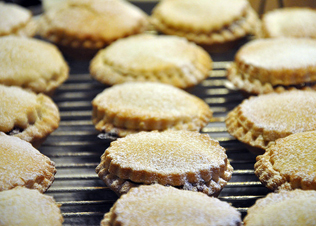News
How to make shortcrust pastry
Tuesday, December 11th, 2012
While there is some very good all-butter frozen pastry available these days from speciality shops, there’s something satisfying about making your own pastry from scratch and being able to claim that your tart or pie is 100% homemade. If you’ve never made pastry before, it’s best to start off with shortcrust pastry, the simplest and one of the most widely used pastries. You can use shortcrust pastry for most tarts and pies, and you can double or triple the recipe and freeze what’s left to use later.
A big complaint amongst home cooks is that pastry shrinks when it bakes.
Tips to avoid shrinking:
• Make sure you rest the pastry in the refrigerator for a minimum of 20 minutes after making it.
• When you roll the pastry out, use short, gentle rolling strokes. Long, hard strokes when pushing down on the rolling pin damages the pastry and makes it shrink in the oven.
• After you’ve rolled the pastry out and lined your tin or dish with pastry, refrigerate it again for 20 to 30 minutes to rest and relax it.
• Set your oven temperature high (220 degrees C) for the first 10 minutes of baking to ‘set’ the pastry, then lower the temperature (180 degrees C) to cook through.
How to make shortcrust pastry by hand
Ingredients:
200g cake flour
100g butter, firm and cool (not hard and cold), diced
30–45ml ice water
Pinch of salt
Sift the flour and salt into a large bowl. Add the diced butter and rub it into the flour using your fingertips. When you rub the butter in, use quick, light movements, and lift your hands high up over the bowl as you rub with your fingertips. You might feel silly, but the lifting helps to incorporate air into the pastry, making it light and crisp. It’s also very important to be quick, so that you don’t soften the butter too much with the heat from your fingertips.
When the mixture has the appearance of coarse breadcrumbs, add 30ml of ice water and use a metal spatula or a butter knife to mix it into the flour and butter. The mixture should start to stick together in walnut-sized clumps; if not, add a bit more water and mix again. (Try not to add more than 45ml of water.)
Tip the pastry out of the bowl and quickly press it together into a ball, then shape the ball flat into an oval.
Wrap the pastry well with cling film and place in the fridge to rest for at least 20 minutes before you use it. When you are ready, remove it from the fridge and let it warm a little – not enough to be soft, but you have to be able to roll it out without it breaking into bits.
Dust your counter top with flour and lay the pastry disk on the flour. Dust the top of the pastry with a little more flour, and use a rolling pin to gently roll out the pastry. Don’t press down onto the pastry when you roll; let the rolling motion rather than the pressure flatten the pastry.
When the pastry has reached the right size and thickness, you can line whatever tart or pie dish you’re using and go ahead with the rest of your recipe.
How to make shortcrust pastry in a food processor
Fit the processor with the blade attachment. Sift the flour and salt and add it to the food processor bowl along with the cubed butter. Pulse the mixture and watch it carefully – you should pulse only until the mixture resembles coarse breadcrumbs.
Add 30ml ice water and pulse again, just a few times before checking the consistency. Again, add more if you think you need it, but pulse only enough to combine after each addition of water. Then tip the pastry out of the processor and continue as described above. Be careful not to over-process, which can make the pastry tough and hard.
By Emma-Kate Liebenberg
Photographs: iJammin, balise42, cookbookman17, gematrium and Nick J Webb.
In the mood for a pie? Try out your new skills with one of these recipes:
Chicken, leek and mushroom pie
Mini pork pies
Hearty winter lamb shank pies
Chicken pie
Almond and apple pie
Autumn harvest potato and mushroom pie
Cheesy celeriac, potato and bacon pie








